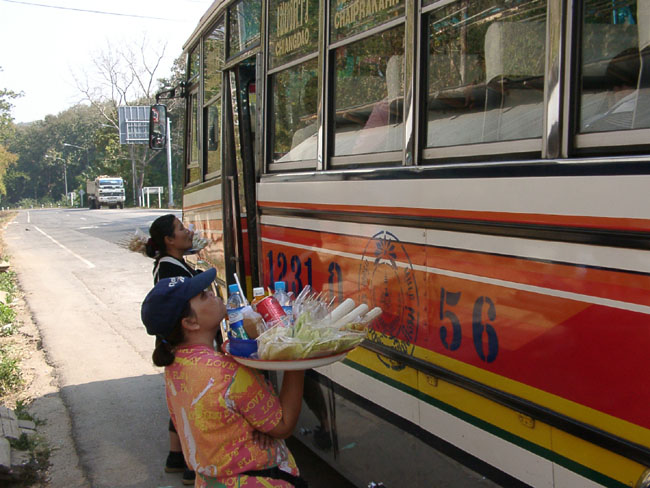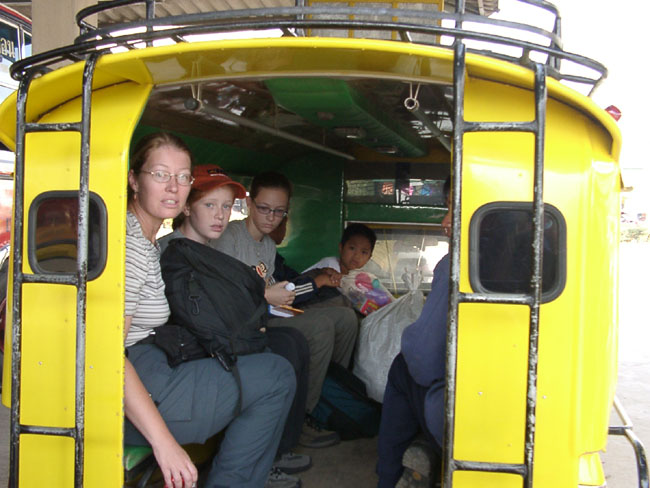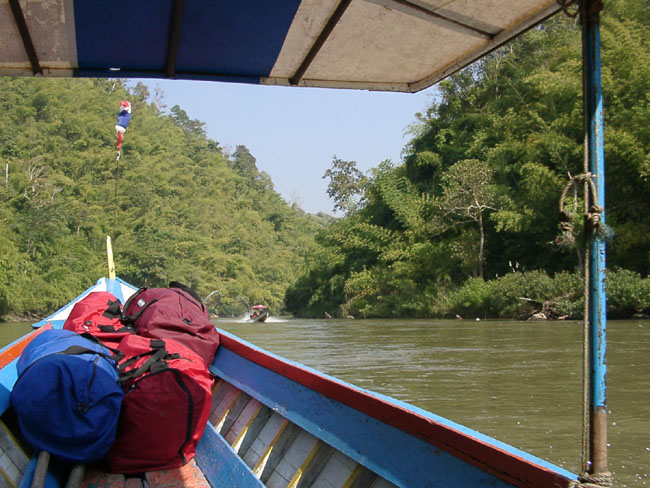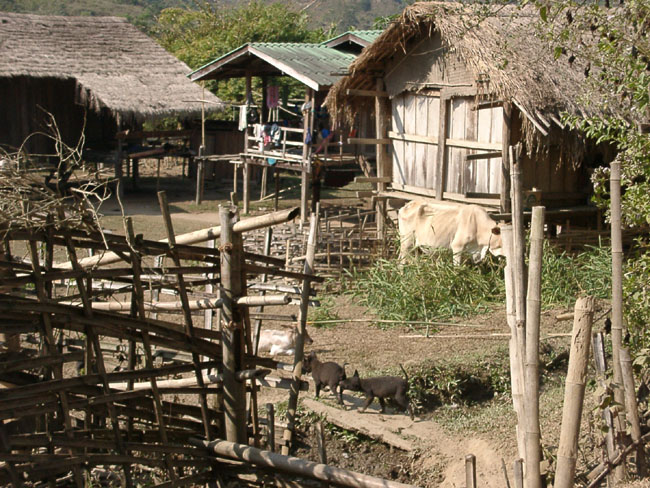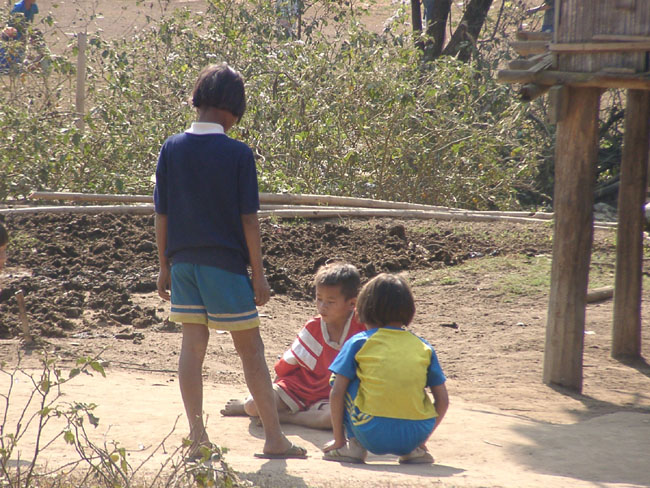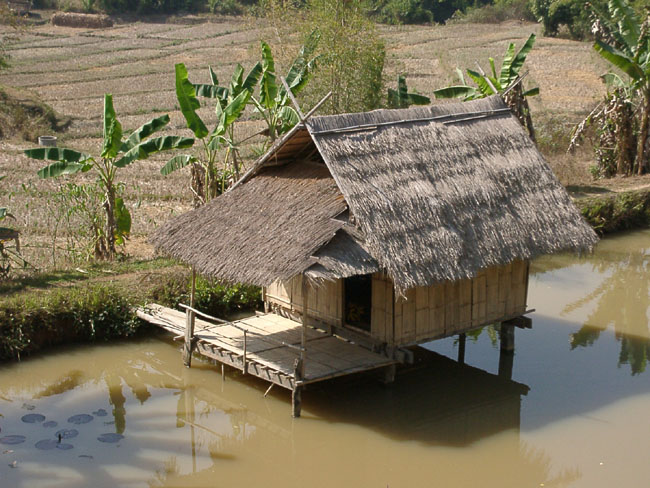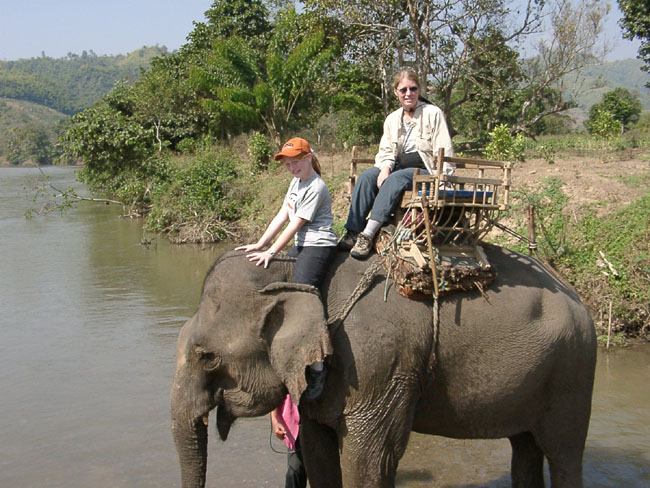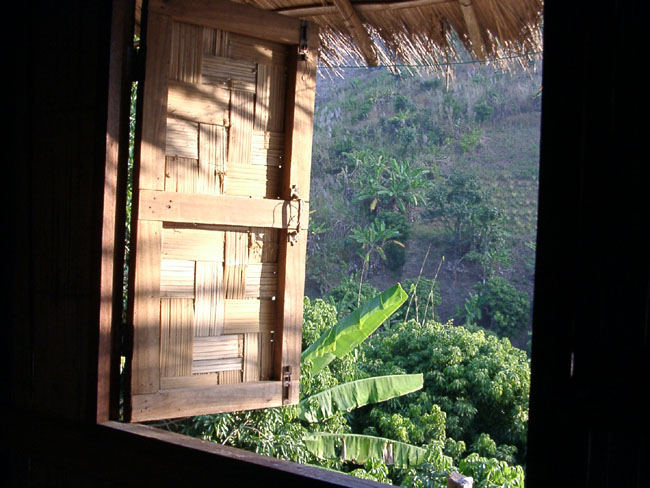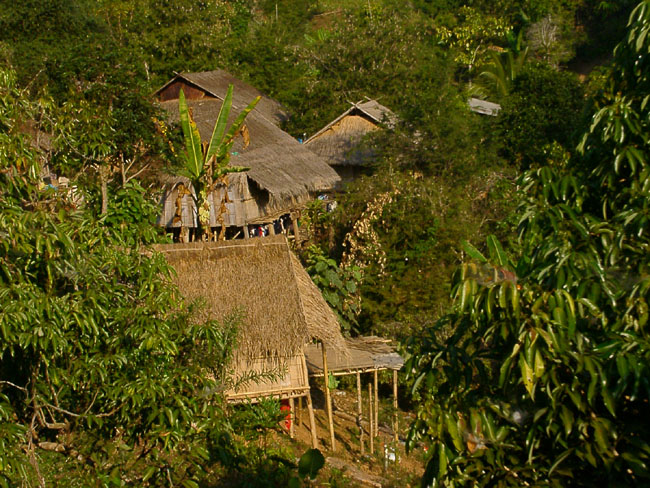| «Back to Previous Post |
Date: Saturday, 10 January 2004 04:37 PST
Subject: Greetings from the Golden Triangle
Captions for photos:
1. Bus from Chiang Mai to Fang on a break
2. Back of modified pick-up truck that we took from Fang to Tha Ton. Twenty-seven passengers eventually squeezed into the cab as well as into and onto back of this vehicle.
3. Photo out the longboat as we made our way down the Mae Kok
4. Lahu village on the Mae Kok (first stop)
5. Children playing with large wooden tops at the Lahu village
6. “Floating house” in Karen village (second stop)
7. Elephant ride in Karen village
8. The view out our bungalow in the Akha village
9. Other “native” buildings in the Akha village
10. A typical Thai lunch served in Chiang Mai. The dishes included: lamb curry with rice, beef noodles, chicken and vegetables, spring rolls and Chinese dumplings. Total cost of food – US$3.50.
10 January 2004 – Day #112
We are currently on a bus back to Chiang Mai. We’ve spent the last week in the north near where the boarders of Thailand, Myanmar (Burma) and Laos meet. This region has been dubbed the Golden Triangle because of one of the cash crops grown here – opium.
When we last wrote, we were on the all-night train from Bangkok to Chiang Mai (population 160,000). Chiang Mai has over 100 temples in the main city; we visited three prominent ones. We also visited the night market, which is Chiang Mai’s number one tourist attraction. There, we found hundreds of stalls, hawking everything from garments to electronics and handicrafts. The handicrafts are largely handmade by the hill people. The prices were so good, we felt a little guilty bargaining.
After two nights in Chiang Mai, we boarded a bus headed north toward Fang (pronounced “Fong”). Because most of our train ride from Bangkok to Chiang Mai was at night, this four-hour ride gave us a chance to see the countryside. It was drier than we imagined but still very green (we learned later the north is two months into their dry season). Along the way, we saw villages surrounded by farms. Based on what we saw, the major crops are grown here are bananas, melons and teak.
Towards the end of our bus ride, the terrain turned from flat to rolling hills to rather large mountains with karst peaks (similar to the peaks of Guilin in southern China). The bus stopped many times to take on or let off passengers. It evidently also provides a delivery service. Several times, the driver “slowed to 20” so that the young man in the back could drop a package out the back. At this point, the driver would toot the horn twice and hit the gas.
When we arrived in Fang (population perhaps a few thousand), we transferred to another vehicle – a covered pick-up truck. One by one, Darren threw our bags to the driver who placed them onto the luggage rack on the roof. We left the bus station five minutes after we arrived with 11 people inside. During our trip, people got on and off. In the middle of the 45-minute trip, a young hill-tribe woman, dressed in colorful clothes, jumped onto the back. Including the sleeping baby strapped to her back, we counted 27 passengers (three in the cab – not including the driver, 19 in the back of the truck and five riding on the bumper).
At last, we arrived in Tha Ton (population less than a thousand, including the hill people in the surrounding area). Tha Ton is on the Mae Kok river literally on the border with Myanmar (Burma). Tha Ton represented the beginning of the hill-tribe portion of our journey.
After one night in Tha Ton, we took a longboat 35 miles down the Mae Kok. We had chartered the boat and a captain the night before. On the way, we had the opportunity to visit a Lahu village (population 40). With no road other than the river itself and no electricity, this village was quite isolated. They lived in elevated huts made of timber, bamboo and grass. We saw chickens and pigs in pens as well as fields with crops. They had dogs as pets (other tribes such as the Akha eat dogs but the Lahu do not). The older men lounged outside one the decks of one of the huts. Looking around, we saw a young man making thread by spinning cotton fibers on his bare leg. After dying this thread, the women in this village make handicrafts such as purses and other bags.
The children played with large wooden tops near the village center. We learned later that men also play tops at night with “life-or-death” contests. Darren took pictures as Sandy and Lauren bargained for a few items. Kristen kept watch for pirates with the captain at the river’s edge.
A few more hours down the Mae Kok, we came to a Karen village (population 200 to 300). There are approximately 322,000 Karen in northern Thailand (more than half the total number of hill people). The Karen are known as elephant handlers. With newer technology gradually displacing these giants as well as a diminished amount of logging, the Karen in this village have tried to diversify. We did our part to support the local economy by taking two elephants for an hour ride around surrounding countryside – Lauren and Darren rode on one elephant with Sandy and Kristen on the other.
At first, the handlers rode on the elephant’s neck. However, 15 minutes into the ride, they both dropped to the ground in order to make room for the kids, who slid down from the basket on the each elephant’s back. The handlers continued to control the elephants with voice commands as they walked along the well-worn trail. While the ride looked fairly even on the neck, both Darren and Sandy were tossed around in their baskets. It was sunny, hot and humid. After the ride, we transferred to another longboat so that our captain could return to his village before nightfall. We then continued one more hour downstream to Chiang Rai.
In the late afternoon, we were picked up by a double-cab pick-up truck at the longboat dock in Chiang Rai. We traveled 17 miles on tarred, concrete and dirt roads to an Akha village. The last seven miles on the heavily rutted dirt road were murder. We rode in the back along with our gear and three other people. There were four other people in the front with Mr. Apae, our driver. During the last few miles, we drove through two villages – the first one was Thai and second Chinese – before arriving at our destination. We saw lots of happy, uniformed kids returning from the area’s primary schoolhouse.
We spent two nights in the Akha village at the Akha Village Hill House. The two-person bungalows at the hill house were “rustic.” Like the other buildings in the village, they were made of timber, bamboo and straw. The mattresses were as hard as a rock. We had a deck completely constructed with bamboo that seemed “under-engineered” to Darren. Chickens and dogs roamed freely through the village. These animals seemed to be most active at night. The roosters started to crow at 2:30am on the first night. You could hear them “cock-a-doodle-doo” all the way through the valley as the roosters from each village competed with the others.
After breakfast the next day, we trekked mostly uphill in the hills surrounding our village. At noon, we stopped for lunch. Our guides collected crabs, shrimp and a small fish by diverting a nearby stream. They collected the flowers that form at the bottom of banana bunches. Next, they made cooking bowls, plates, cups and even chopsticks out of bamboo. After some time, they served three delicious dishes using ingredients found in the forest. After lunch, we crossed several streams and passed through the farmland and homes of a Yao village. We finished our trek with a visit to a beautiful triple-level waterfall before returning to the village.
On the drive back to Chiang Rai, we rode in the cab with Mr. Apae. We learned some interesting background about this particular Akha village. First, Mr. Apae turned out to be the village chief. Surprisingly, this is an elected position with a four-year term. Second, we learn that the village converted to Christianity thirty years ago. The entire village attends church every Sunday in a small chapel in the village. Finally, we learned that students wanting to continue their education past sixth grade have to live in dormitories in Chiang Rai during the week. The village had built a dormitory there. Mr. Apae supports the education of seven children (six for secondary school and one at university) through the proceeds generated by the Hill House. It felt good to contribute to this “local economy”.
In Chiang Rai, we went to the Hill tribe Museum that covers the particulars of each tribe as well as the history of the opium trade. Chiang Rai also had a night market that was “kinder and gentler” as compared to the one in Chiang Mai. In both cities we also enjoyed excellent Thai food.
After one more night in Chiang Mai, we will make our way to the airport for the first of two flights to Phnom Penh, Cambodia. There, we plan to learn about the “Killing Fields” before traveling up the Tonle Sap River by boat to Siem Reap, the location of Angkor Wat.
God’s Blessings,
Darren
| «Back to Previous Post |

